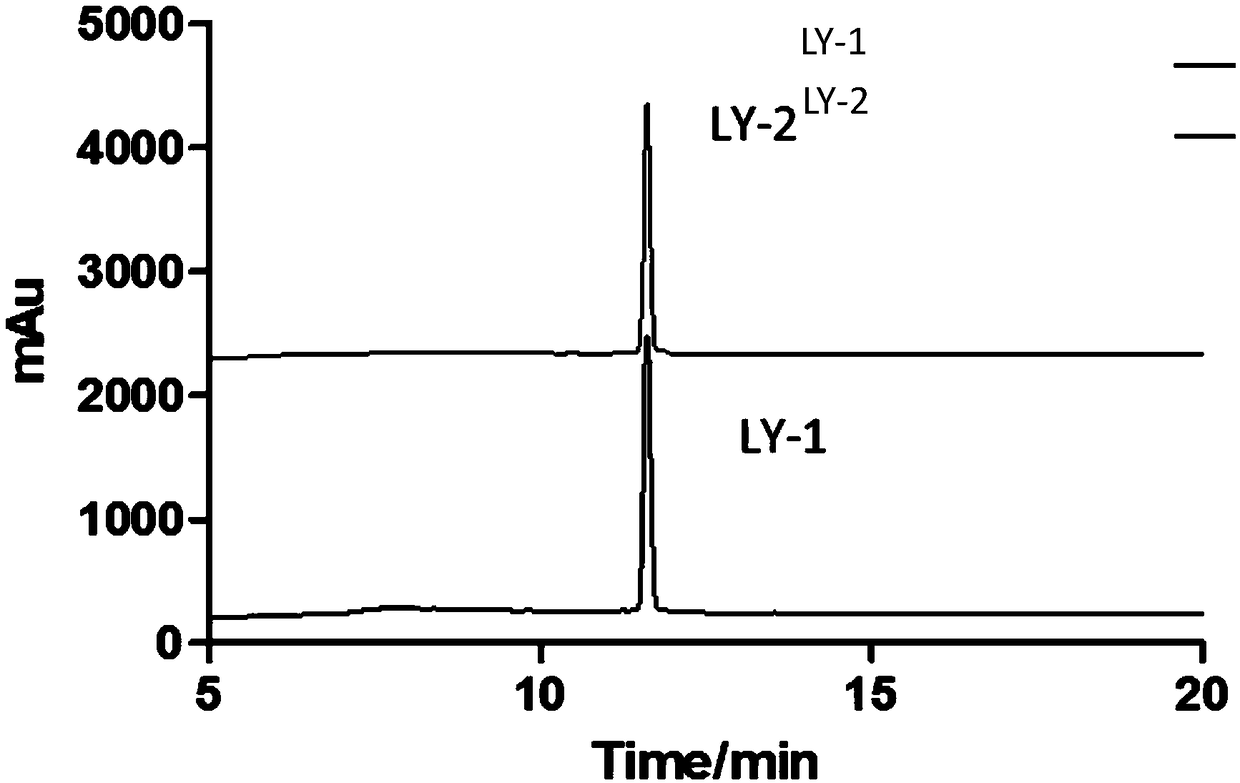Hypoglycemic peptide and application thereof
A technology for hypoglycemia and diabetes, applied in the biological field, can solve problems such as hypoglycemia, serious adverse reactions, and inconvenient administration
- Summary
- Abstract
- Description
- Claims
- Application Information
AI Technical Summary
Problems solved by technology
Method used
Image
Examples
Embodiment 1
[0039] Example 1 Simulated gastrointestinal digestion to reduce the stability of glycopeptides
[0040] Simulated gastrointestinal digestion experiment: Accurately weigh 3 mg of hypoglycemic peptide (amino acid sequence shown in SEQ ID NO: 1), dissolve it in 100 ml of deionized water, adjust the pH of the solution to 2.0 with 1 mol / L hydrochloric acid; add 0.12 mg of pepsin After stirring, incubate in a constant temperature shaker at 37°C for 2h; heat the sample in a boiling water bath for 10min to inactivate the enzyme. Then adjust the pH of the solution to 7.5 with 1 mol / L sodium hydroxide solution; add 0.12 mg of trypsin, stir moderately and incubate in a constant temperature shaker at 37°C for 2 hours, and finally heat in a boiling water bath for 10 minutes to inactivate the enzyme.
[0041] The hypoglycemic peptide (denoted as LY-1) after the simulated gastrointestinal digestion experiment was detected by high performance liquid chromatography, and the untreated hypoglyce...
Embodiment 2
[0043] Example 2 Glucose Consumption Test of Smooth Muscle Cells
[0044] Smooth muscle cells (VSMC) in the logarithmic growth phase were taken, and 8×10 4 Cells / mL were seeded in a 96-well plate at a seeding volume of 100 μL / well. After the cells grew adherently, the supernatant was discarded. Divide VSMC cells into three groups: the first group (blank group, abbreviated as NG), add 100 μL / well of low-glucose medium; the second group (model group, abbreviated as HG), add high-glucose medium, 100 μL / well ; The third group (experimental group) set 4 groups of different conditions, respectively added high glucose culture solution containing 5 μM, 10 μM, 20 μM, 40 μM hypoglycemic peptide (sequence shown in SEQ ID NO: 1), 100 μL / well; Six replicate wells were set up for each concentration. Among them, the low-sugar culture medium is DMEM medium supplemented with 10% serum (glucose concentration is 5 mM), and the high-sugar culture medium is DMEM medium supplemented with 10% seru...
Embodiment 3
[0046] Example 3 Effects of Hypoglycemic Peptides on Diabetic Mice
[0047] 1. Modeling method of diabetic mice
[0048] This paragraph describes the method for modeling diabetic mice. Thirty C57BL6 male mice, each weighing 20±2g, were provided by Wuxi Shanhe Pharmaceutical Company. Feed with common feed for 1 week to adapt to the environment. After that, 10 mice in each group (fed separately, 5 mice / cage), were randomly divided into 3 groups: normal control group (marked as WT), STZ-induced model group (marked as STZ), experimental group (marked as for STZ+AOP). The STZ-induced model group and the experimental group received intraperitoneal injection of STZ (streptozotocin), 50 mg / kg, for 5 days; the normal control group received the same amount of sodium citrate injection. Seven days after the end of STZ administration, fasting for 12 hours, the tail blood was taken to test the fasting blood glucose of the mice. It was found that the blood glucose values of the mice in...
PUM
 Login to View More
Login to View More Abstract
Description
Claims
Application Information
 Login to View More
Login to View More - Generate Ideas
- Intellectual Property
- Life Sciences
- Materials
- Tech Scout
- Unparalleled Data Quality
- Higher Quality Content
- 60% Fewer Hallucinations
Browse by: Latest US Patents, China's latest patents, Technical Efficacy Thesaurus, Application Domain, Technology Topic, Popular Technical Reports.
© 2025 PatSnap. All rights reserved.Legal|Privacy policy|Modern Slavery Act Transparency Statement|Sitemap|About US| Contact US: help@patsnap.com



